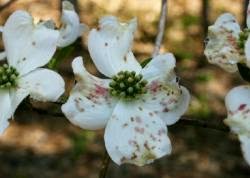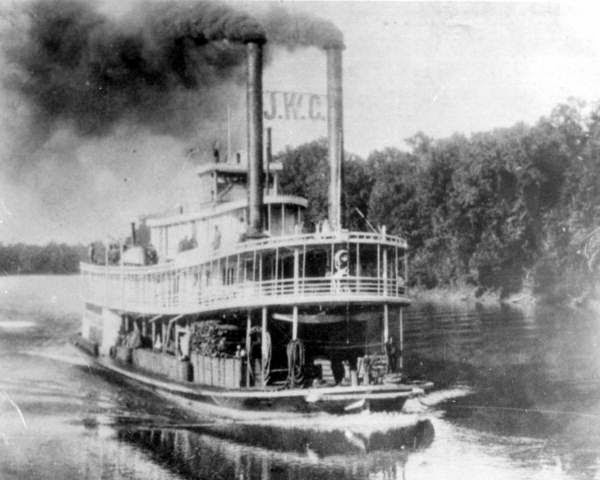 |
| Map showing location of Widow Hull's Place Click to Enlarge |
Although Jackson County was established by act of the Florida Territorial Legislative Council in 1822, it took a couple of years to get its government up and running. This was largely due to the massive size of the original county, which then extended from the Suwannee River on the east to the Choctawhatchee River on the West and from the south lines of Alabama and Georgia to the Gulf of Mexico.
 |
| U.S. Land Patent for Sarah Hull Click to Enlarge |
By the time the first census was taken in 1825, the size of the original county had been carved down considerably by the creation of other new counties. The population that year, however, included only 213 families scattered from the Alabama line to the Gulf of Mexico. Marianna had not yet been established, although the modern towns of Greenwood and Campbellton were identifiable communities.
On April 18, 1825, the three members of the Jackson County Court (comparable to today's county commissioners) met at the home of Mrs. Sarah Hull to appoint a commission that would recommend a site for a permanent county seat. It is by virtue of this meeting that Mrs. Hull's place, often called "Widow Hull's Place," can be considered the first county seat of Jackson County.
 |
| Waddell's Mill Pond About one mile upstream from Widow Hull's Place |
According to a patent in the General Land Office Records at the Bureau of Land Management, Sarah Hull obtained the Northwest 1/4 of Section 2, Township 5 North, Range 11 West directly from the land office in Tallahassee. Exactly when she settled on the property is not clear, but her patent was approved in Washington by President John Quincy Adams in 1827. Since she was living on the parcel in 1825, it is likely that she settled there at some point between that date and the transfer of Florida from Spain to the United States in 1821. Thomas Hull, evidently a grown son, acquired adjoining land in Section 3.
Mrs. Hulls' home was located on the south side of Waddell's Mill Creek, downstream from Waddell's Mill Pond between the mill dam and today's Bump Nose Road. The site is on private property.
 |
| Cristoff's Ferry on the Chipola River The ferry was in use by 1825. |
Although the records are silent as to the reason her home was selected as a location for the meeting of the county court, it probably was picked due to its convenient location near the road leading from Cristoff's Ferry on the Chipola River. Centrally located in the area of the county where settlers were establishing themselves, it was a reasonable place for a meeting.
Convening at Mrs. Hull's house on April 18, 1825, were Jacob Robinson, William S. Pope and Joseph Russ. They appointed three commissioners - Dr. William P. Hort, James Patterson and Owen Williams - to find a permanent place for building a courthouse and county seat.
The commissioners viewed several locations before settling on the West 1/2 of the Southwest 1/4 of Section 4 in Township 4 North, Range 10 West. This is the present site of Marianna.
 |
| Marianna later grew on the proposed site of the Town of Chipola |
The County Court returned to Mrs. Hull's on June 10, 1825, to receive the recommendation of the commissioners and the members seemed to have been pleased, noting in their minutes that the future site of Marianna was "the most Eligible site for the public buildings of said County."
Things seemed to be going well and, from the temporary county seat at Mrs. Hull's, the County Court moved forward with plans for a town where Marianna would later stand. On July 11, 1825, the court members met at Widow Hull's and ordered Deputy Clerk Court/County Surveyor John B. Jackson to lay out the "Town of Chipola" on the designated site. A plat was prepared and a sale of lots was set for October 19.
The plan began to fall apart shortly before the date of the sale. The three members of the County Court met again at Mrs. Hull's place on October 17, 1825, just two days before the planned sale. Some controversy developed and two of the judges - Jacob Robinson and Joseph Russ - reconvened the next day and declared the selection of the site for a permanent county seat to be illegal. The reason why they believed it to be so was never explained.
 |
| Site of Webbville |
Instead, from their meeting at the Widow Hull's, the two judges ordered the permanent county seat to be established on a different site in Section 22, Township 5 North, Range 11 West. This site is about two miles southeast of the intersection of today's State Highway 73 and U.S. 231 north of Cottondale.
The new location for a permanent county seat was immediately southeast of Section 16 of Township 5 North, Range 11 West, where the town of Webbville would soon grow.
The selection of this site led to all out political war in Jackson County. Multiple elections would follow, as would decisions from both the Territorial Legislature and the U.S. Congress. In the end, the city of Marianna (founded in 1827) would emerge as the winner in the battle for county seat.
Although it would take years of political fighting to decide the location of a permanent county seat, the Widow Hull's Place holds the distinction of being Jackson County's first county seat by virtue of the fact that the county court met there repeatedly over an extended period of time. Mrs. Hull was not still in Jackson County by the time the county seat battle was decided. She relocated to Quincy prior to 1830.
Widow Hull's Place, the long forgotten first county seat, is #78 on our list of 100 Great Things about Jackson County, Florida.

































